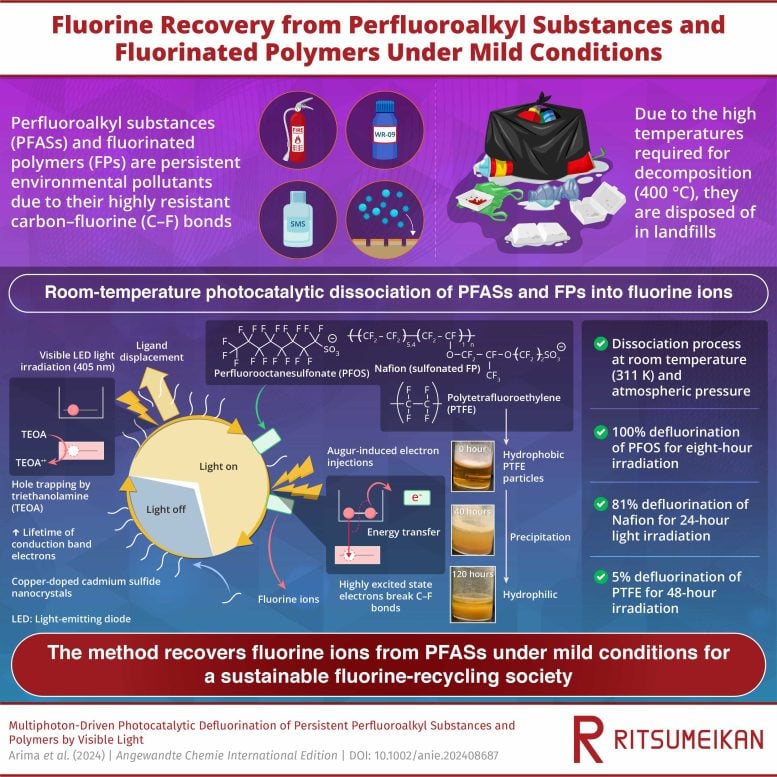A new study by Ritsumeikan University researchers presents a method to defluorinate PFASs at room temperature using visible light, achieving complete breakdown of these harmful chemicals into fluorine ions within eight hours, thus enabling sustainable recycling of fluorine for industrial use.
The room-temperature defluorination technique presents a promising approach for handling perfluoroalkyl substances.
Perfluoroalkyl substances (PFASs), commonly known as ‘forever chemicals,’ represent an increasing risk to both the environment and public health. Developed initially for Teflon in 1938, PFASs and related perfluorinated polymers (PFs) have found widespread use due to their remarkable stability and resistance to heat and water. These characteristics have made them indispensable in numerous products, including cookware, clothing, and firefighting foam. However, this very stability has become a major problem.
PFASs do not easily break down in the environment, leading to their accumulation in water, soil, and even the bodies of humans, where they are known to cause carcinogenic effects and hormonal disruptions. Today, these chemicals can be found in drinking water supplies, food, and even in the soil of Antarctica. Although there are plans to phase out PFAS production, treating them remains challenging as they decompose only at temperatures exceeding 400 °C. As a result, certain amounts of products containing PFASs and PFs end up in landfills, potentially creating future contamination risks.
Innovative Defluorination Research
Now, a room-temperature defluorination method proposed by researchers at Ritsumeikan University could revolutionize PFAS treatment. Their study, published in the journal Angewandte Chemie International Edition, details a photocatalytic method that uses visible light to break down PFAS and other fluorinated polymers (FPs) at room temperature into fluorine ions. Using this method, the researchers achieved 100% defluorination of perfluorooctanesulfonate (PFOS) within just 8 hours of light exposure.
“The proposed methodology is promising for the effective decomposition of diverse perfluoroalkyl substances under gentle conditions, thereby significantly contributing towards the establishment of a sustainable fluorine-recycling society,” says Professor Yoichi Kobayashi, the lead author of the study.

Perfluoroalkyl substances and fluorinated polymers are efficiently decomposed into fluoride ions under ambient conditions by irradiating visible LED light onto semiconductor nanocrystals. The decomposition is driven by cooperative mechanisms involving light-induced ligand displacement and Auger-induced electron injection, utilizing hydrated electrons and higher excited states. Credit: Professor Yoichi Kobayashi from Ritsumeikan University, Japan
Details of the Photocatalytic Method
The proposed method involves irradiating visible LED light onto cadmium sulfide (CdS) nanocrystals and copper-doped CdS (Cu-CdS) nanocrystals with surface ligands of mercaptopropionic DOI: 10.1002/anie.202408687
The study was funded by the Japan Science and Technology Agency, the Japan Society for the Promotion of Science, and Kyushu University.














/https://tf-cmsv2-smithsonianmag-media.s3.amazonaws.com/filer_public/d1/82/d18228f6-d319-4525-bb18-78b829f0791f/mammalevolution_web.jpg)



;Resize=(1180))

Discussion about this post